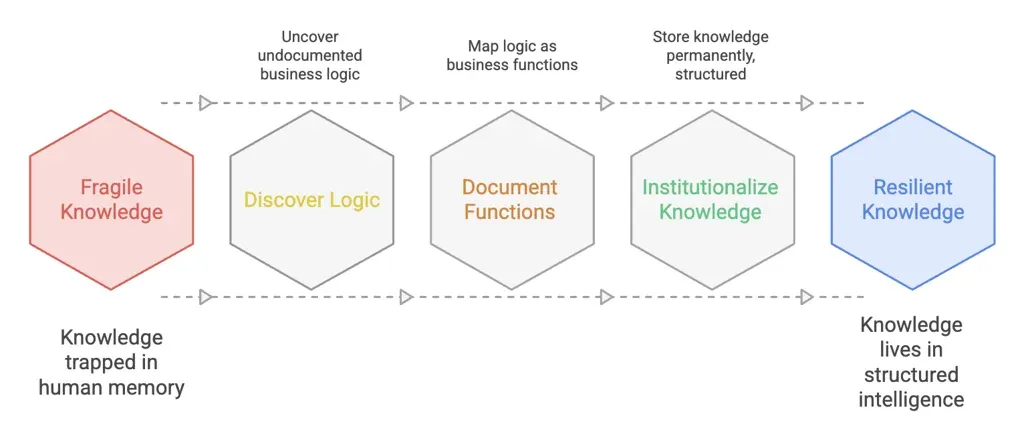As we explored in Part I, 220 billion to 800 billion lines of COBOL code still power 80% of the world's financial transactions—an empire built by a generation now walking toward the exits. But here's the gut punch nobody talks about at budget meetings: When Maria retires next month, she's taking the unwritten manual with her.

The Hidden Asset: Business Functions Trapped in Code
That 40,000-line loan processing module Maria maintains? It's not just code. It's a catalog of business functions—discrete capabilities your organization depends on:
- "Calculate compound interest for savings accounts with early withdrawal penalties"
- "Validate mortgage applications against 1992 FHA regulations"
- "Generate end-of-quarter regulatory reports for SEC filing"
- "Handle overdraft protection for joint accounts with secondary authorization"
Each function represents decades of refined business logic, compliance requirements, and edge-case handling. This is institutional intelligence—the real reason your COBOL systems are irreplaceable.
When Maria leaves, these capabilities don't vanish. The code keeps running. But your ability to understand, modify, and evolve these functions? That disappears with her.
Business Function Discovery: The Paradigm Shift
Here's the breakthrough that changes everything: What if you could automatically discover every business function in your COBOL systems—mapped, documented, and traceable—before your experts retire?

Business Function Discovery works by analyzing your codebase to identify and extract discrete business capabilities. Instead of drowning in technical complexity, you get answers like:
Question: "What does the loan origination system actually do?"
Answer: A complete inventory:
- "Validate applicant credit scores against lending thresholds"
- "Calculate debt-to-income ratios for qualification"
- "Apply state-specific interest rate caps"
- "Generate disclosure documents for regulatory compliance"
- "Route applications to underwriting based on risk assessment"
Each function includes:
- Natural language descriptions (no COBOL expertise required)
- Deterministic traceability back to exact source code lines
- Business context: Why this function exists and what it accomplishes
- Dependencies: How it connects to other functions and systems
From Brain Drain to Brain Trust
This fundamentally changes the retirement conversation. Maria's knowledge doesn't need to live only in her memory anymore. Business Function Discovery institutionalizes what was once personalized.
Before Discovery (Fragile):
- "We need Maria to explain how overdraft protection works"
- "Don't touch Module XYZ—only Tom understands it"
- "The mortgage calculation is somewhere in those 15,000 lines"
- New hires spend 18 months becoming productive
After Discovery (Resilient):
- Complete catalog of business functions, instantly queryable
- Every function documented with business intent and technical implementation
- New developers productive in days, not years
- Impact analysis becomes deterministic: "Changing this function affects these 7 other capabilities"
- Maria's retirement is a celebration, not a crisis
The Strategic Transformation
When you have a complete inventory of business functions, suddenly everything changes:
For Modernization: You know exactly what to preserve, what to enhance, and what to retire. No more guesswork about whether Module X is still needed.
For Compliance: When auditors ask "Where do you enforce GDPR right-to-delete?"—you answer in seconds with traceable proof.
For Business Continuity: Leadership can see the complete map of capabilities that drive revenue, satisfy regulations, and serve customers.
For AI Enablement: Business functions become a structured knowledge graph—the foundation for advanced analytics, intelligent automation, and AI-powered decision support.
The Bottom Line
The COBOL brain drain isn't unsolvable. It's only a crisis when business capabilities remain trapped in human memory.
The real question isn't "How do we find more COBOL developers?" It's "How do we preserve and expose the business intelligence these systems contain—before that knowledge walks out the door?"
Tools like COBOL Colleague are flipping this script, analyzing codebases to discover and document business functions in minutes instead of months. They don't replace your retiring experts; they immortalize their genius as permanent, queryable intelligence.
Maria can retire with peace. Your business functions survive—understood, documented, and ready for the next generation.
What’s Ahead?
Watch this space for the next chapter in our series—where we’ll dive deeper into how uncovering business functions transforms modernization, compliance, business continuity, and AI enablement. Over the coming weeks, we’ll break down each pillar, showing how your organization can move from legacy risk to future-ready resilience. Stay tuned for actionable insights, real-world stories, and a roadmap to turn your hidden COBOL knowledge into your greatest strategic asset.
What's your organization's biggest knowledge gap right now? Let's solve the brain drain crisis together—one business function at a time.
Discussion Starters:
- If you could instantly discover all business functions in your most critical legacy system, which system would you choose first?
- What's one business capability in your COBOL code that you wish was better documented?
- How would your modernization strategy change if you had a complete catalog of business functions before starting?
